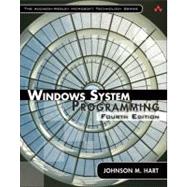The Definitive Guide to Windows API Programming, Fully Updated for Windows 7, Windows Server 2008, and Windows Vista
Windows System Programming, Fourth Edition, is the definitive guide to programming with Windows' core APIs, including the new APIs introduced with Windows 7, Windows Server 2008, and Windows Vista. Thoroughly updated to reflect today's best practices, this is the one book you need to write high-performance applications with Windows' core system services.
This best-selling Windows API guide now contains extensive new coverage of 64-bit programming, parallelism, multicore systems, and many other crucial topics. Johnson Hart's robust code examples have been updated and streamlined throughout. They have been debugged and tested in both 32-bit and 64-bit versions, on single and multiprocessor systems, and under Windows 7, Vista, Server 2008, and Windows XP. To clarify program operation, sample programs are now illustrated with dozens of screen shots.
Hart systematically covers Windows externals at the API level, presenting practical coverage of all the services Windows programmers need, and emphasizing how Windows' functions actually behave and interact in real-world applications. Hart begins with features used in single-process applications and gradually progresses to more sophisticated functions and multithreaded environments.
Topics covered include file systems, memory, exceptions, processes, threads, synchronization, and interprocess communication.
New coverage in this edition includes Leveraging parallelism and maximizing performance in multicore systems.
Promoting source code portability across Windows, Linux, and UNIX Using 64-bit address spaces and ensuring 64-bit/32-bit portability Improving performance and scalability using thread synchronization, condition variables, and thread pools.
Ensuring coexistence between .NET managed code and unmanaged code
When, why, and how to use the Windows API vs. .NET








